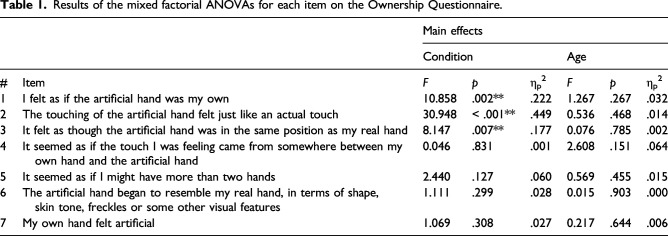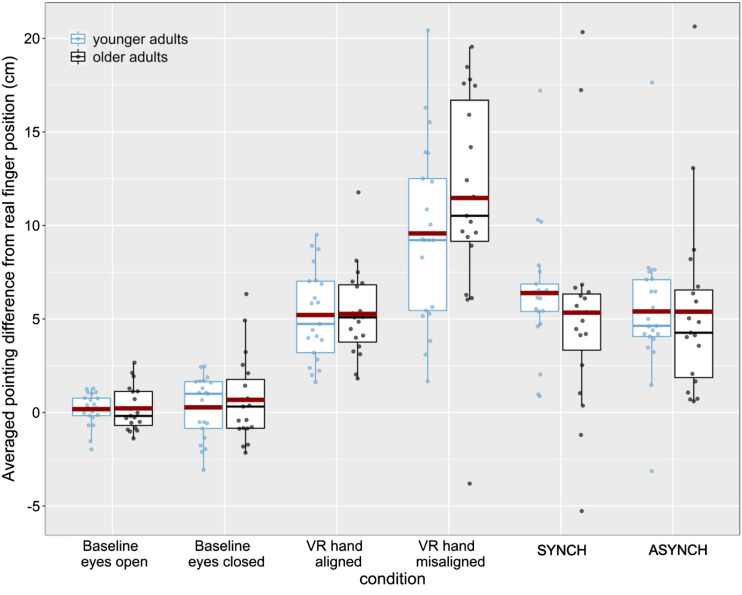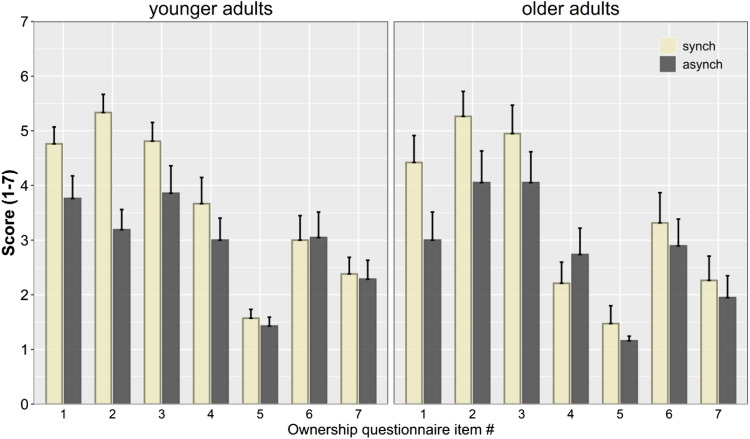年轻人和老年人的虚拟手错觉。
IF 2
Q3 ENGINEERING, BIOMEDICAL
Journal of Rehabilitation and Assistive Technologies Engineering
Pub Date : 2021-12-07
eCollection Date: 2021-01-01
DOI:10.1177/20556683211059389
引用次数: 1
摘要
化身包括体验对我们身体的所有权,并将其定位在空间中,并通过多种感官(视觉、本体感受和触觉)获得信息。有证据表明,具体化和多感觉统合可能随着年龄的增长而改变。虚拟手错觉(VHI)已被用于研究多感官对化身的贡献,但从未在老年人中进行过评估。虚拟环境所特有的时空因素可能会对老年人和年轻人的具身感知产生不同的影响。方法:21名年轻人(18-35岁)和19名老年人(65岁以上)完成了VHI范式。在同步和异步视觉-触觉交互之后,身体定位在基线和主观所有权评级中被测量。结果:在同步条件下,相对于异步条件下,观察到更高的所有权评分,但没有发现对定位/漂移的影响。没有观察到年龄差异。当虚拟手与真实手对齐时,两个年龄组的定位精度都存在偏差,这表明虚拟手在视觉上定位错误。结论:VHI无年龄相关差异。在虚拟现实中,两组的手都出现了定位错误,即使是在一致和对齐的情况下;然而,触觉反馈减少了定位偏差。我们的研究结果扩展了目前对虚拟环境中多感官体现中年龄相关变化的理解。本文章由计算机程序翻译,如有差异,请以英文原文为准。



Virtual Hand Illusion in younger and older adults.
Introduction Embodiment involves experiencing ownership over our body and localizing it in space and is informed by multiple senses (visual, proprioceptive and tactile). Evidence suggests that embodiment and multisensory integration may change with older age. The Virtual Hand Illusion (VHI) has been used to investigate multisensory contributions to embodiment, but has never been evaluated in older adults. Spatio-temporal factors unique to virtual environments may differentially affect the embodied perceptions of older and younger adults. Methods Twenty-one younger (18–35 years) and 19 older (65+ years) adults completed the VHI paradigm. Body localization was measured at baseline and again, with subjective ownership ratings, following synchronous and asynchronous visual-tactile interactions. Results Higher ownership ratings were observed in the synchronous relative to the asynchronous condition, but no effects on localization/drift were found. No age differences were observed. Localization accuracy was biased in both age groups when the virtual hand was aligned with the real hand, indicating a visual mislocalization of the virtual hand. Conclusions No age-related differences in the VHI were observed. Mislocalization of the hand in VR occurred for both groups, even when congruent and aligned; however, tactile feedback reduced localization biases. Our results expand the current understanding of age-related changes in multisensory embodiment within virtual environments.
求助全文
通过发布文献求助,成功后即可免费获取论文全文。
去求助
来源期刊

Journal of Rehabilitation and Assistive Technologies Engineering
ENGINEERING, BIOMEDICAL-
自引率
5.00%
发文量
37
 求助内容:
求助内容: 应助结果提醒方式:
应助结果提醒方式:


